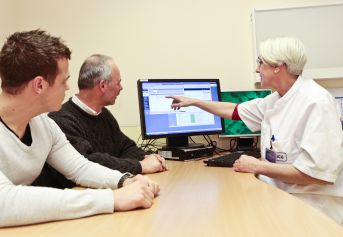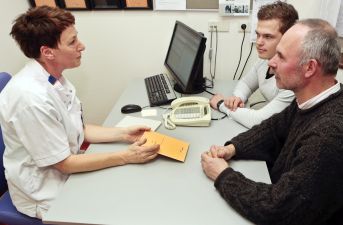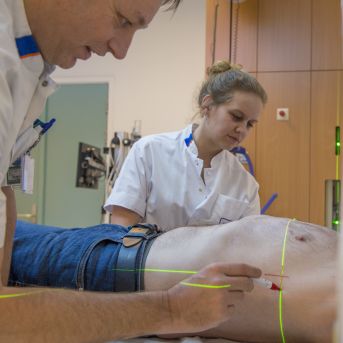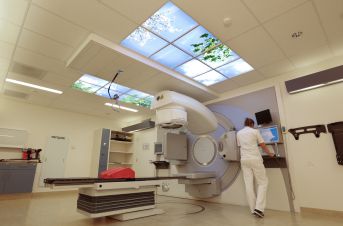Your treatment - What to expect
An overview of your treatment
Your radiotherapy treatment consists of a meeting with your radiation-oncologist, a meeting with an assistant from ‘Patientservice’, acquisition of diagnostic imaging in preparation of your treatment, and the actual treatment. The sections below provide details to each of these steps. Our 360-degree video’s (not yet available in English) allow you to experience all steps in the radiotherapy treatment process in advance.
As of January 2018, we are the first radiotherapy department in the Netherlands to offer proton therapy. On this page you can find a video about a patient’s experience of proton therapy.
Step 1: First consultation with your radiation-oncologist
Your first visit with the radiation-oncologist is called your consultation visit. The radiation-oncologist (or a radiation-oncologist in training) will ask questions about your medical history and personal circumstances. Your primary care physician or your treating physician has already sent us your relevant medical details. It is important to inform us about any medication you are using. This first consultation often includes a physical exam.
The radiation-oncologist will inform you about the number of radiotherapy treatment sessions and the treatment technique that will be used (photon radiotherapy, proton therapy or brachytherapy). You will also be informed about the treatment-related side-effects that may occur and the expected treatment outcome. It is important to realize that there is no relation between the duration of each treatment session and the severity of your illness. Before determining the best treatment approach, the radiation-oncologist may need to consult other physicians or may request additional exams.

Step 2: Meeting with Patientservice
Your first meeting with Patientservice will typically take place immediately after your consultation with the radiation-oncologist. The Patientservice assistant will
- ask if you have any remaining questions,
- inform you about the daily radiation treatment routine at our department of radiation-oncology,
- inform you about the possibility of treatment-related side-effects,
- instruct you about asking questions and advice during your radiation treatment process,
- give instructions for skin care.
The assistant may need to determine your weight and/or draw blood.
On business days, Patientservice can be reached by phone, between 8:15 – 11:30 AM and between 1:00 and 4:00 PM, at +31 50 361 9365.

Related information:
Download Medical assistants Radiotherapy
Step 3: Treatment preparation
Making a mask:
If you will receive radiation treatment for a tumor in the head and neck region, we will make a mask to ensure a consistent and reproducible head and neck posture. The radiotherapy treatment technologist (RTT) can furthermore mark the mask with lines that will help in aligning you to the radiation beams. The mask is made of plastic material. This material becomes flexible when heated in warm water, allowing it to be molded to the shape of your head and neck.
Determining the region to be treated:
To apply radiotherapy with the highest accuracy, it is important to exactly determine the location and shape of your tumor. We acquire a CT-scan of the region of your body where the tumor is located. It may be that we also acquire a PET/CT-scan and/or an MR-scan. You will receive the relevant additional information prior to these exams. Treatment preparation may differ between patients. In your first consultation, your radiation-oncologist will inform you about the required steps to prepare for your treatment.
It is very important for you not to move during all preparatory steps for your radiation treatment. This allows the RTT to accurately mark the treatment region on your skin.
 Marking the area to be irradiated
Marking the area to be irradiated
Making the treatment plan:
Your presence is not needed for this step. Prior to your first radiotherapy treatment session and based on the acquired imaging, the RTT and radiation-oncologist will determine the optimal treatment plan. The treatment plan ensures that the tumor will be irradiated with the highest possible accuracy, while minimizing the amount of radiation delivered to your healthy tissues. As it takes some time to prepare and to validate this treatment plan, your first radiation treatment session will take place a few days after image acquisition.
Step 4: Applying the radiation treatment
On each day of treatment, you check in at your treatment machine by placing your UMCG-card in the designated bin. You can then find a seat in the waiting room.
An RTT will guide you to a changing room and, subsequently, to the radiation treatment room. The RTTs will assist you to lie down in the same posture as used during acquisition of your CT-scan. Using the marks on your mask and/or skin, and X-ray imaging, the RTTs will align you to the radiation treatment beams. When you and the treatment machine are ready, the RTTs will leave the treatment room and start the radiation treatment. You will have to remain still for the duration of this treatment. Cameras in the treatment room allow the RTTs to monitor you during treatment delivery.
You will not be able to see, hear or feel the radiation itself. Depending on the complexity of your treatment, each treatment delivery can last from tens of seconds to tens of minutes. As soon as the treatment is completed and the treatment machine is turned off, the radiation will be gone immediately. You will not be(come) radioactive and people will not receive any radiation dose from being near you.
After treatment completion, you can continue your everyday business.
 One of the linear accelerators
One of the linear accelerators

 English
English
 Nederlands
Nederlands